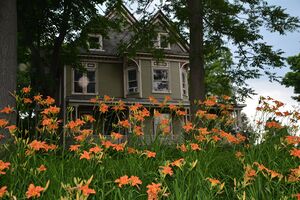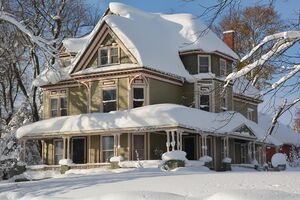- Profile
- Images
Location: 3693 Bowen Road, Lancaster, New York
"These two Yankee style barns with their low-pitched gable roofs are probably the largest barns now standing in Lancaster. Located southwest of the corner of Bowen Road and William Street, they can best be seen from Bowen Road.
Situated further from William Street is the older barn dating to about 1850. Unpainted, this barn was a dairy barn and was always meant to be a working barn. The one closer to William Street at the higher elevation was probably erected in the 1880's. Although similar in size and shape to the other, this was always a much fancier barn. Probably intended for horses and carriages when built, it has a tack roo with polished woodwork inside the east entrance. The house at the corner is a large Queen Anne style Victorian home dating to the 1890's. It was built as a summer home for a family who ran a hotel in Buffalo. Sited on a ridge with an east-west axis along which William Street runs, it has a commanding view over the fields to the south and east where the Summerfield Farms Subdivision is now taking shape. The house has a large porch and, at one time, had apon cochere on the north side. The stone piers for the port cochere are still standing. With open sides and a roof, this feature provided cover from rain and snow when one drove a carriage under it.
The farm belonged to the Kimball family in the mid-1800's. More recently, it belonged for several decades to the Huff family.
In 1850, Norman Kimball owned a three hundred acre farm at this location. An ardent abolitionist, his son Martin Kimball, who was born in 1830, was a “runner” in the Underground Railroad. Other runners identified by the late Town Historian, Eleanor Bissell, were her father, Augustus Bissell, James Atwood, Peter Dykstra, Phillip (Thomas) Peckham, and Watson Blackmon, all of whom lived on Broadway. Their leaders were Joseph Swanbro and Joseph Yurann, both of Bowen Road.
Mr. Ezra Sterling Ely lived in Cheektowaga. His barn stood on the northeast corner of Como Park Boulevard and Indian Road.
"All were on call with fast horses at any time to carry fugitives from one station to the next ... ... Utmost secrecy had to be observed as breaking Federal Law, as they were doing, was a serious offense, punishable by imprisonment and heavy fines.”
“The wagon they used was a large hay rack with an extra-wide rave which held six men lying prone. Over the rack were piled corn stalks as a cover for the men. This wagon was stored in Mr. Ely's barn and was always called the slave wagon'. "
(excerpts from The Underground Railway in Lancaster and Cheektowaga, by Eleanor Bissell) (1)

|

|

|

|

|

|
Source
- Login to edit this profile and add images.
- Public Comments: Login to post. (Best for messages specifically directed to those editing this profile. Limit 20 per day.)





